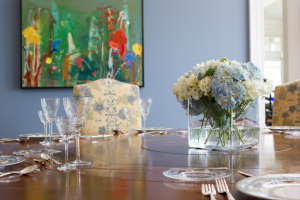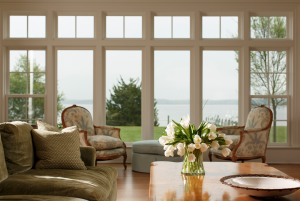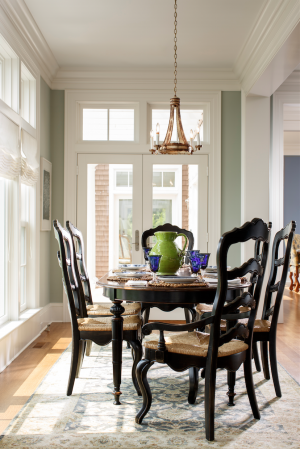- © 2024 Annapolis Home Magazine
- All Rights Reserved
By Kymberly Taylor | Photography by David Burroughs
To outsiders, the Eastern Shore reveals itself slowly. Some miss it entirely. Far too often, the uneducated zoom by on their way to the ocean, trying to avoid police lurking at Dairy Queen with radar guns. Most folks who live on the Shore are fine with that. They exude the air of knowing things you don’t: where the soft crabs nestle, how to stock a freezer full of wild fowl, the simple pleasure of a pause.
Phil and Marlene Feldman possess such knowledge. Phil was born and raised in Cambridge, Maryland, and has spent his entire life fishing and hunting, aware of where the sun rises on the horizon, the solstices, which influence the tides, which, in turn, affect your fishing plans. You would not know this, but beneath his business suit is a man in constant touch with water. (For proof, see the Tide app on his phone.)
 A graduate of the University of Maryland, he now owns several commercial insurance companies located on the East and West Coasts. He and his wife Marlene have been married thirty-seven years, many of them spent raising children in a much-loved waterfront home in Cambridge. When they bought twenty acres, most of it farmland, on the Choptank River, they wanted to build an equally special house, where they could deepen their connections to each other and to nature.
A graduate of the University of Maryland, he now owns several commercial insurance companies located on the East and West Coasts. He and his wife Marlene have been married thirty-seven years, many of them spent raising children in a much-loved waterfront home in Cambridge. When they bought twenty acres, most of it farmland, on the Choptank River, they wanted to build an equally special house, where they could deepen their connections to each other and to nature.
After interviewing several architects, they chose Scarlett Breeding of Alt Breeding Schwarz Architects in Annapolis. “Scarlett wanted to hear what we wanted, and didn’t impose any ideas on us,” says Marlene. “That was important to us.” Mindful listening is integral to Breeding’s design process. Before rendering a single drawing, she poses a simple question to her clients: What and where were your happiest memories, what shapes and forms accompanied them?
Then, she travels to the places they have lived in and loved and, in this way, begins to divine what is in their soul and what images make them happy. With this powerful knowledge, she incorporates into the new space familiar, beloved forms. “I look very hard for the soul of the person and I try to express that soul in the finished product,” Breeding says. “That makes people happy, because that is what they were looking for in the first place.”

What helped her most is that the Feldmans knew themselves, and knew what they liked. Marlene wanted a home with character and complexity, conducive to entertaining, able to center an ever-growing family. “Phil grew up hunting, fishing, guided by the spirit of the Eastern Shore,” notes Breeding. To succeed, she knew she must conceive architecture grounded and true, yet supple enough to mediate this wild, sparkling force.
With this in mind, she designed a variation of a classic Shingle-style home tucked between a fifteen-acre cornfield and the river. Its pure lines recall the Shingle style yet also reference the Eastern Shore’s vernacular architecture, with a multi-faceted roofline composed of both gables and gambrels. These traditional forms reference the evolution of the Shore’s vibrant agricultural industry, filled with working farms, barns, and sprawling homes that rise from irrigated fields to stand alone against the sky. Marlene walked Breeding through her former home and pointed out her favorite spot: a seating area just off the kitchen. A version of this appears in the new house.
 Marlene also furnished her new home with items from her Cambridge residence, cherishing their connectivity to her former life. The beds in the guest room are from the previous house, and the bed in the master faces a wall of windows overlooking the water, as it did before. There are family antiques and objects that look well-loved, such as the freshly polished round dining room table, with a custom built-in lazy susan for self-serving, and, upstairs, the wooden deck chairs weathered to the color of strongly-brewed tea.
Marlene also furnished her new home with items from her Cambridge residence, cherishing their connectivity to her former life. The beds in the guest room are from the previous house, and the bed in the master faces a wall of windows overlooking the water, as it did before. There are family antiques and objects that look well-loved, such as the freshly polished round dining room table, with a custom built-in lazy susan for self-serving, and, upstairs, the wooden deck chairs weathered to the color of strongly-brewed tea.
During her deliberations, Breeding had to make concessions or rather, make way for the cornfield. This meant eliminating a staple of the classic prestigious Shore home: a long, tree-lined drive leading straight to the front door. This would not do for Phil, who did not want a driveway interfering with his field. “He drew an imaginary line and said, ‘well that is about as much as we are going to be able to use for the house, the rest I want to keep in crops,’” says Breeding.
 Her team had to figure out a new “sequence of arrival.” This sequence is important because it influences the way one first experiences a house. “We now had to arrive at the end of the house as opposed to arriving at the center of the house,” Breeding recalls. To foster a similar, if smaller drama, she designed a long curving drive that follows the edge of the forest, approaches the back side of the house, and defers to the field.
Her team had to figure out a new “sequence of arrival.” This sequence is important because it influences the way one first experiences a house. “We now had to arrive at the end of the house as opposed to arriving at the center of the house,” Breeding recalls. To foster a similar, if smaller drama, she designed a long curving drive that follows the edge of the forest, approaches the back side of the house, and defers to the field.
Every room reveals views of the river or field. These opposing primal elements seem to charge the air—as if nature is planning a take-over. “There’s a lot going on in this field. I know this sounds crazy but you can almost see the corn growing at this time of year,” says Phil. “It’s just amazing how it changes from day to day. Osprey feed in the field, dove feed in the field, the great blue heron comes in. Marlene and I watch it and talk about it all the time.”
The field and waterfront, the entire twenty acres, are mesmerizing. Perhaps it has to do with the disheveled charm of the duck blind, just a few yards from the beach, commandeered by an osprey. Or, that you can gaze for miles and see nothing but a single line dividing the wheat from the corn. It is easy to see why some never leave the Shore, why some hesitate to cross the Bridge. They have been drawn into its invisible biologies, its vast uninhibited unconscious that flows just beneath the surface of the rivers and fields, in search of souls.
Resources:
Architect: Scarlett Breeding, Alt Breeding Schwarz, www.absarchitects.com
Landscape Architecture: Campion Hruby Landscape Architecture, www.campionhruby.com
Building and Construction: Bob Lukas, General Contractor, 410.463.0454
From Vol. 5, No. 4 2014
Annapolis Home Magazine